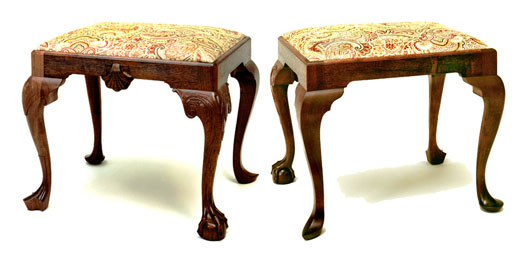The Georgian Footstool

Every year, students in the NBSS cabinet and furniture making program have the option to make a Georgian footstool.
Students who take the footstool workshop learn to work with and understand wood in ways that differ from mortise-and-tenon or dovetail joinery. In large part, the footstool is not about joinery, it is about shaping — taking a square blank, applying a pattern, roughing it out, fairing the curve and working it to a final shape. Turned work and moldings bear some resemblance in that symmetry, proportion and light are important to the final piece, but shaping the footstool legs occurs in three dimensions making it closer to carving.
The NBSS Georgian footstool is unique to the furniture making program at NBSS. The workshop has been developed by instructors over the past fifteen years to pack as much into as small a project as possible. Because seating and tables need at least three, and typically four feet, why not make each foot different? The Georgian footstool includes four different feet — pad, slipper, trifid and ball-and-claw.
Two views of a Georgian footstool by Pete Micheline, CF ’08 made when he was a student. Click on the photo to see more of footstool images and click here to go to Charles Hamm, CF ’13’s blog entry with even more photos of the process.
The one thing that each of the four legs has in common is the cabriole — the shape that moves the eye from the knee to the foot. The cabriole leg is typified by a reverse ‘S’ shape. When viewed in profile, the legs have two S curves – on the inside there is a tight concave which moves towards the floor and ends in a shallower convex on the back of the ankle while the outside starts with shallow convex on the knee and ends on the foot with a tight concave.
Once the patterns are cut and faired, there are a few options as to how to proceed. In the pad foot we work the blank until the leg has a circular cross section at any given point parallel to the floor. The slipper has a square profile while both the trifid and the ball and claw are treated differently for the carving that will be done on the knees. No matter how you decide to shape the leg, it is remarkable how compelling the shape that emerges can be.
This story is based on the blog of cabinet and furniture making student Charles Hamm, CF ’13. Find his blog online here.
